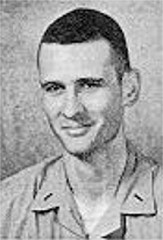Robert Ray Duncan was born on March 16, 1942 and joined the Armed Forces while in West Palm Beach, Florida.
He served in the United States Navy, VA 85, and attained the rank of Lieutenant.
Robert Ray Duncan is listed as Missing in Action.
There is a “In Memory of” Stone in his name in Arlington National Cemetery.
Name: Robert Ray Duncan
Rank/Branch: O2/US Navy
Unit: Attack Squadron 85, USS AMERICA (CVA 60)
Date of Birth: 16 March 1942
Home City of Record: W. Palm Beach FL
Date of Loss: 29 August 1968
Country of Loss: North Vietnam
Status (in 1973): Missing In Action
Category: 2
Acft/Vehicle/Ground: A6B
Other Personnel In Incident: Alan F. Ashall (missing)
Source: Compiled by Homecoming II Project 01 April 1990 from one or more of the following: raw data from U.S. Government agency sources, correspondence with POW/MIA families, published sources, interviews. Updated by the P.O.W. NETWORK 1998.
REMARKS: SURVIVAL UNLIKELY
SYNOPSIS:
Lieutenant (jg) Robert R. Duncan was a pilot and Lieutenant (jg) Alan F. Ashall a
bombardier/navigator assigned to Attack Squadron 85 onboard the aircraft carrier USS AMERICA (CVA 60). On August 29, 1968 he launched from the aircraft carrier in their A6B Intruder on an armed reconnaissance mission in theVinh Son area of North Vietnam.
Duncan and Ashall launched at 1:00 a.m. and proceeded to their assigned station. Three surface-to-air missiles (SAM) were observed in the area. A transmission was received from the aircraft reporting that they were experiencing radion trouble, and then a transmission that sounded like, “SAMs in the air” followed by “We shot a missile” or “I got a missile”. No distress signals were received and efforts to contact them were unsuccessful.
Search and rescue efforts were initiated immediately, but the results were negative. There was a large fireball observed on the ground in the vicinity where the aircraft disappeared. It was suspected that the aircraft took a direct or disabling hit by one of the three SAMs or collided with the terrain while attempting to avoid the enemy fire.
Duncan and Ashall were classified Missing in Action. The Defense Intelligence Agency further expanded their classification to include an enemy knowledge ranking of 2. Category 2 indicates “suspect knowledge” and includes personnel who may have been involved in loss incidents with individuals reported in Category 1 (confirmed knowledge), or who were lost in areas or under conditions that they may reasonably be expected to be known by the enemy; who were connected with an incident which was discussed but not identified by names in enemy news media; or identified (by elimination, but not 100% positively) through analysis of all-source intelligence.
The Commander of the Seventh Fleet, Vice Admiral William F. Bringle, acknowledged that the missions required of the A6 pilots over North Vietnam
were among “the most demanding missions we have ever asked our aircrews to fly.” However, he added, “there is an abundance of talent, courage and aggressive leadership” in the A6 squadrons.
Now, nearly 20 years later, men like Duncan and Ashall are all but forgotten except by friends, family and fellow veterans. The U.S. “priority” placed on determining their fates pales in comparison to the results it has achieved.
Since Duncan and Ashall went down, nearly 10,000 reports have been received by the U.S. relating to Americans who are still prisoner, missing or unaccounted for in Southeast Asia. Many officials who have seen this largely classified information are now convinced that hundreds of Americans are still alive in captivity. Whether Duncan and Ashall are among them is not known.
Michael Robert Patterson was born in Arlington and is the son of a former officer of the US Army. So it was no wonder that sooner or later his interests drew him to American history and especially to American military history. Many of his articles can be found on renowned portals like the New York Times, Washingtonpost or Wikipedia.
Reviewed by: Michael Howard


